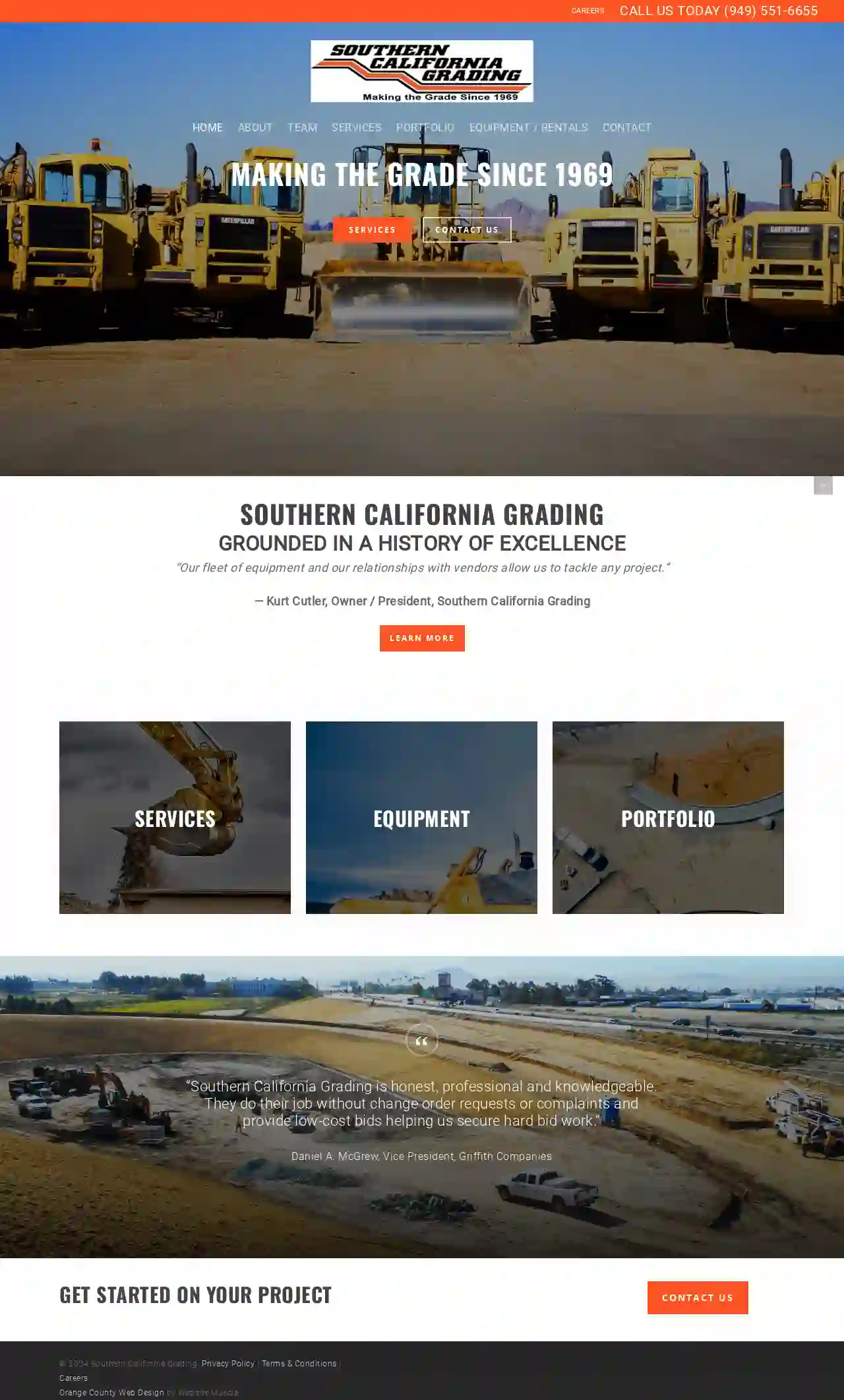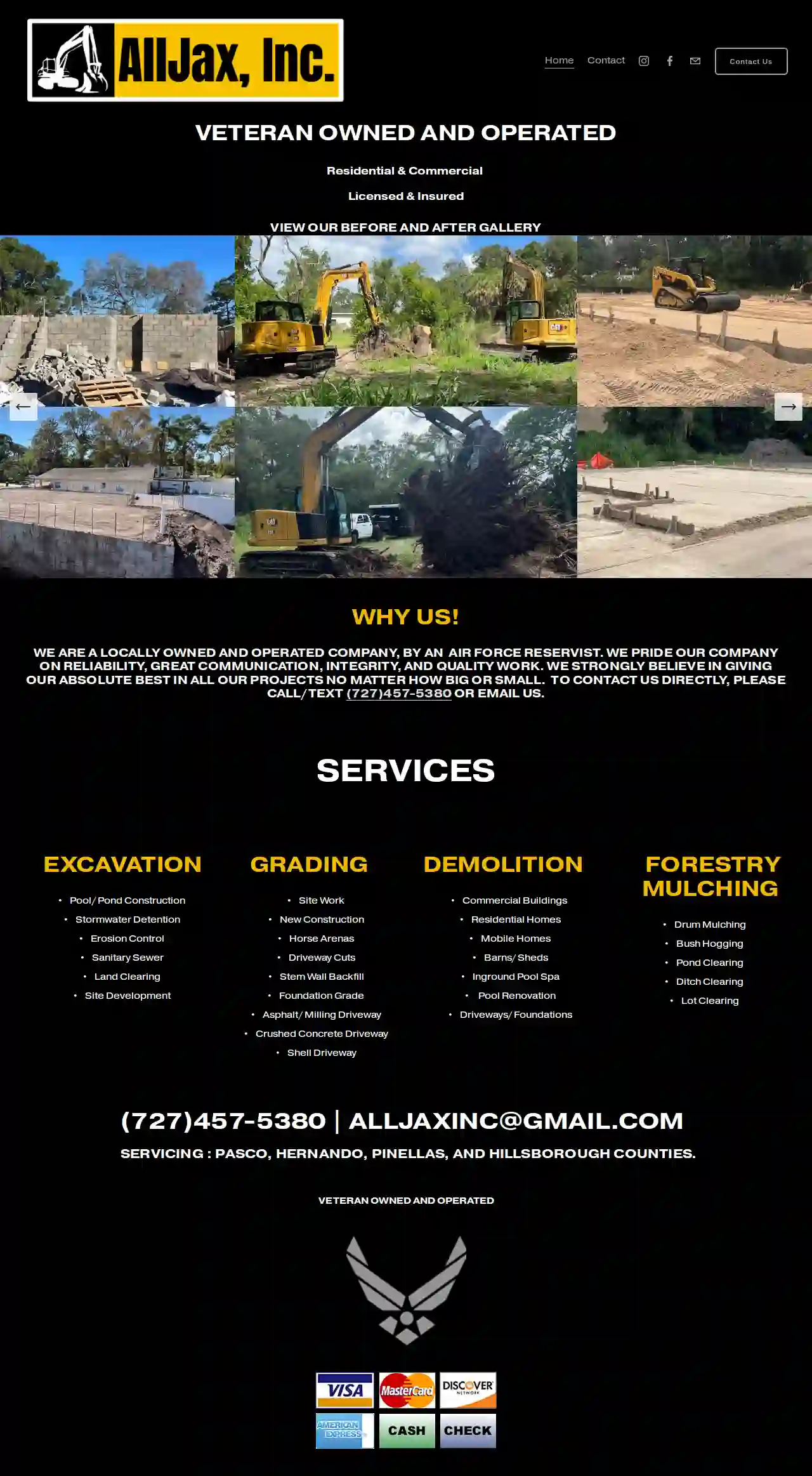Excavation Contractors El Cerrito
Find top Excavation Contractors in El Cerrito
Get multiple Excavation Contractor quotes for your project today! Compare profiles, reviews, accreditations, portfolio, etc... and choose the best offer.

Geobear Foundation Repair
536 reviews22603 La Palma Suite 302, Yorba Linda, 92887, USRepair Your Foundation Issues At Their Source Loose and subsiding soils wreak havoc on foundations, causing cracking, settlement, and sinking slabs. Our geopolymer injection process repairs your compromised soils and restores load-bearing integrity. Learn How Geopolymer Injection Works We repair weak soils using a high density geopolymer that is specifically formulated for supporting foundations and concrete slabs. The geopolymer works by filling the voids present in the soils and underneath the slab, and then compacting it into dense matrix or geopolymer in soil. This process reestablishes the soils weight-bearing capacity and contact to your foundation slab. Precision and Excellence Over 200,000 structures treated worldwide We invented the geopolymer soil stabilization solution over 37 years ago, developing and refining the process that has been saving homes and foundations across the globe. The fact is our proprietary techniques, processes, diligence, and polymers are all built around our experiences, successes, and failures that make sure each and every project is done right. This is why our work is guaranteed for 10 years! What to expect from Geobear? Honesty, Professionalism, and a Hassle Free Experience. In our almost 4 decades of experience and over 200,000 projects, we've learned to make the soil repair process as easy an experience as possible. We help homeowners skip costly and disruptive processes that require excavation, heavy equipment, and weeks to months of installation time. Our geopolymer injection solution is so clean and easy that you don't have to move out and the work can be completed in 1-2 days. This means repairing your problem, completing the project in less time, and major cost savings. So why choose Geobear? Because it's a better way.
- Services
- Why Us?
- Testimonials
- Gallery
Get Quote
Coastal Excavation & Construction Inc
51 reviewsPO 585, Goleta, 93116, USMeet Chad Cushman - Founder of Coastal Ex Founded in 2007 by Santa Barbara native and avid waterman, Chad Cushman - Coastal Ex started with a vision as expansive and clear as the California coastline. Just as the coast is a dynamic meeting point of land and sea, Cushman saw an opportunity to bridge creativity and stability in the construction industry. Cushman’s strong compass, guided by a commitment to quality, reflects his unwavering dedication to excellence amidst ever-changing conditions. Each project under his direction embodies his commitment to meticulous craftsmanship and innovative thinking and problem solving in a dynamic industry. Coastal Excavation and Construction continues to stand as a testament to the integrity and enduring quality that define his vision and the essence of the coastal spirit. When he’s not on site with his team, you can find Chad in his workshop welding, tending to his growing orchard or swimming in the Pacific Ocean that he’s grateful to call his backyard. Decades of Results Coastal Excavation & Construction is a highly skilled and licensed general engineering contractor specializing in a wide range of services, from custom design and drawings to demolition, excavation, grading, trenching, pipe installation, backfill, drainage, erosion control, footings, foundations, structural building, light duty building, pool excavation, driveways, hardscapes, septic systems, fire prevention, land clearing, heavy duty landscaping, and hauling. With a commitment to quality and customer satisfaction, Coastal Ex has been serving the Santa Barbara County and Central Coast communities for over 15 years. Their team of experienced professionals is dedicated to providing exceptional service and delivering projects on time and within budget. Whether you're looking to build your dream home, renovate your existing property, or tackle a challenging landscaping project, Coastal Ex has the expertise and resources to make your vision a reality.
- Services
- Why Us?
- Our Team
- Gallery
Get Quote
Lowland Grading & Excavation LLC
58 reviewsAberdeen, USPrompt and Reliable We prioritize delivering results swiftly and dependably, all the while ensuring that we meet and exceed the expectations of our clients every time. Satisfaction Guaranteed At our core, we're a seasoned team driven by our expertise and know-how, dedicated to success. We are here to offer you not only ease, but absolute satisfaction.
- Services
- Why Us?
- Gallery
Get Quote
H.I.G Contractors
54 reviews123 Main Street, Anytown, 12345, USAbout HIG Contractors HIG Contractors is a family-owned and operated business with over 20 years of experience in the construction industry. We are committed to providing our clients with high-quality workmanship and exceptional customer service. We specialize in a wide range of construction services, including: Residential construction Commercial construction Renovations Additions Roofing Siding Windows and doors Decks and patios And more! We are fully licensed and insured, and we are proud to be a member of the Better Business Bureau. We are committed to providing our clients with a positive and stress-free construction experience. We work closely with our clients to ensure that their project is completed on time and within budget. We are also committed to using environmentally friendly building practices whenever possible. If you are looking for a reliable and experienced construction company, look no further than HIG Contractors. We are dedicated to providing our clients with the highest quality construction services available.
- Services
- Why Us?
- Testimonials
Get Quote
Goldenline Construction
4.9150 reviews6449 INDEPENDENCE AVE., WOODLAND HILLS . CA ., 6449 INDEPENDENCE AVE. WOODLAND HILLS . CA ., Woodland Hills, 91367, USWhy Choose Goldenline Construction as your General Contractor? With over 20 years of experience, Goldenline Construction is your trusted partner for home remodeling and construction services in Los Angeles and Ventura County. We specialize in transforming homes and commercial properties with a deep understanding of local design trends and professionalism in our industry. As a full-service general contractor, we handle every aspect of your project—from planning and permits to final completion. Our commitment to quality, attention to detail, and customer satisfaction sets us apart. Whether it’s a kitchen or bathroom remodel, or a complete home renovation, we deliver results that enhance your living experience and add value to your property. Serving Los Angeles and Ventura County, we have been # 1 General contractor for home owners in cities Woodland Hills, Thousand Oaks, West Hills, Encino, Sherman Oaks, Granada Hills etc. We combine expertise with a passion for excellence, making us the ideal choice for your next remodeling project. Contact us today to learn how we can bring your vision to life.
- Services
- Why Us?
- Gallery
Get Quote
Demolition 4 You
52 reviewsWhittier, 90601, USProfessional Demolition Company in Whittier, CA Looking for an experienced and competent demolition contractor? You have come to the right place. We are Demolition 4 You, a professional company dedicated to offering well-formulated and high-quality services at fair and accessible prices. We operate in and around Whittier, CA and if you are interested in our assistance, keep reading to learn more. Hello, my name is Gilberto De Niz, I am a collaborator in demolition4you. We are a small Southern California demolition company, located in the city of Whittier. We are made up of a multidisciplinary and responsible team, which has extensive experience in the field of demolition and general construction. We offer our services throughout the local area and surrounding areas (L.A, Orange, Ventura & San Bernadino Counties). At demolition4you we are committed to our client’s projects, as the continuous improvement process requires us to provide a quality service at an affordable cost. About Our Excellent Services We have the expertise and technical capacity to correctly and promptly carry out even the most labor-intensive and time-sensitive projects. We will secure the site to protect passers-by and nearby structures from harm and damage. We will diligently bring down the building and save you from the hassle and stress of the task.
- Services
- Why Us?
- Our Team
- Testimonials
- Gallery
Get Quote
Granite Construction Co
4.618 reviews585 West Beach Street, Watsonville, 95076, USGranite Construction: Building a Better Future Granite is a diversified construction and construction materials company, serving as a full-suite provider in the transportation, water infrastructure, and mineral exploration markets. We deliver Infrastructure Solutions for public and private clients throughout the Americas. Our Commitment At Granite, we are committed to building a better future. We believe in building better together, building value together, and building safely together. Our Values Our core values guide everything we do. We are committed to: Safety Integrity Excellence Innovation Sustainability Our History Granite has a long and rich history, dating back to 1922. We have a proud tradition of building quality infrastructure that stands the test of time. Our Team Our team is made up of some of the most talented and experienced professionals in the industry. We are committed to providing our employees with the resources and support they need to succeed.
- Services
- Why Us?
- Gallery
Get Quote
Urban Irvine Construction
56 reviewsSuite A, 16291 Construction Circle East, Irvine, 92606, USGrounded in a History of Excellence Southern California Grading was founded in 1969 by Bob Cutler and Bob Kehrer—two friends with extensive hands-on engineering and earthwork experience. In our early days, when Orange County was just starting to grow, we forged strong relationships with developers like the Irvine Company. Successful projects ranging from commercial ventures to developing new roads made Southern California Grading essential to bringing people and businesses to Irvine. These efforts began decades-long relationships with our clients and peers in the construction community. A Legacy of Teamwork and Mutual Respect Based in Irvine, California, Southern California Grading is still family-owned, and we pride ourselves on the core values of teamwork and mutual respect. Over the years, we have developed strong relationships with many clients and devoted employees. Some have been with us for over 25 years. Southern California Grading at a Glance $25 million in annual revenues Bondable and insured with an A+ rating Banks with one of the largest U.S. financial institutions Owns and rents its own fleet of heavy equipment Diverse market expertise Our Commitment to Excellence Our core principles of integrity, respect, responsibility and hard work have made us a premier provider of grading and construction services since 1969. We enjoy the challenge of navigating the ups and downs of our industry by focusing on client needs and adapting to industry advancements. A Firm Foundation for Success Today, Southern California Grading has a long history of successful projects throughout California. We’re proud of our reputation as a company that reliably provides a firm foundation for even the most complex building projects. Our experienced employees, technologically advanced equipment, and proven procedures provide assurance that the project will be completed on-schedule, within budget and done right, the first time.
- Services
- Why Us?
- Accreditations
- Gallery
Get Quote
AllJax Inc Excavation, Forestry Mulching & Pond Clearing
4.935 reviewsDavis, USAllJaxInc is a locally owned and operated company, run by an Air Force reservist. We take pride in our reliability, excellent communication, integrity, and high-quality work. We are committed to delivering our best on every project, big or small. We are dedicated to providing exceptional service to our clients in Pasco, Hernando, Pinellas, and Hillsborough Counties. Our team is experienced in a wide range of services, including excavation, pool and pond construction, stormwater detention, erosion control, sanitary sewer, land clearing, site development, forestry, demolition, and grading. We are fully licensed and insured, and we are proud to be a Veteran Owned and Operated business. To contact us directly, please call/text (727)457-5380 or Email Us.
- Services
- Why Us?
- Gallery
Get Quote
Big Bore Drilling
4.828 reviews1522 W Pine, Fresno, 93728-1211, USWelcome To Big Bore Drilling Certified Septic & Hydroflushing Family owned and operated, since 1959, Big Bore Drilling has been providing septic system installation, pumping, repairs and certifications. We also provide hydro-flushing/hydro-jetting as well as boring & drilling services. Call today for a fast and free phone quote. We are located in Fresno California and service Fresno county, Clovis, Madera County, and surrounding mountain areas. Don’t put off a job that we make easy, affordable and delivered with quality. Our Services SEPTIC SYSTEM INSTALLATION & REPAIR SEPTIC TANK PUMPING TEST HOLES DRILLING LEACH LINES SEPTIC REPAIR DRAIN WELLS LIFT STATIONS ENGINEERED SEPTIC SYSTEM INSTALLATION CITY SEWER HOOK-UPS & REPAIR SEPTIC INSPECTIONS HYDROFLUSHING VACUUM DEBRIS REMOVAL HYDRO EXCAVATION
- Services
- Why Us?
- Testimonials
- Gallery
Get Quote
Over 22,076+ Excavation Companies in our network
Our excavation pros operate in El Cerrito & surrounding areas!
ExcavationHQ has curated and vetted Top Excavation Contractors in and around El Cerrito. Find a top & trustworthy business today.
Frequently Asked Questions About Excavation Contractors
- Trench Collapses: Unstable trench walls can cave in, posing a severe risk to workers. Proper shoring and sloping are crucial safety measures.
- Utility Damage: Striking underground utilities (gas, water, electric) can cause leaks, explosions, or electrocution. Accurate utility locates and careful digging are essential.
- Falling Objects: Materials or equipment falling into excavations can injure workers. Securing work areas and using appropriate safety gear is vital.
- Equipment Accidents: Operating heavy machinery involves risks of rollovers, collisions, or mechanical failures. Trained operators and proper equipment maintenance are critical.
- Environmental Hazards: Excavated soil might contain hazardous materials (asbestos, lead). Proper testing and disposal procedures are necessary.
- Planning and Surveying: Defining the excavation area, marking utility lines, and determining the required depth and grade.
- Site Preparation: Clearing vegetation, removing obstacles, and ensuring site accessibility.
- Excavation: Using appropriate equipment (excavators, backhoes, etc.) to remove earth and create the desired excavation.
- Hauling and Disposal: Transporting excavated material to designated disposal sites, complying with environmental regulations.
- Backfilling and Compaction: Refilling the excavation with suitable material and compacting it to achieve the required density and stability.
- Grading and Finishing: Leveling and shaping the surface to the final grade for landscaping or construction.
- Excavators: Versatile machines with a bucket, arm, and rotating cab for digging, lifting, and moving earth.
- Backhoes: Similar to excavators but with a digging bucket on the back and a loader bucket on the front, ideal for trenching and smaller excavations.
- Bulldozers: Powerful machines with a large blade for pushing earth, clearing land, and leveling surfaces.
- Skid Steers: Compact and maneuverable loaders with various attachments (buckets, forks) for digging, loading, and grading in tight spaces.
- Trenchers: Specialized machines for digging narrow trenches for utilities.
- Dump Trucks: Vehicles for hauling excavated material to disposal sites.
What are the risks associated with excavation?
What is the excavation process?
What equipment is used for excavation?
What is the difference between topsoil and subsoil?
Topsoil: The uppermost layer, typically rich in organic matter, nutrients, and microorganisms. It's essential for plant growth and is often darker in color.
Subsoil: The layer beneath the topsoil, containing less organic matter and generally denser. It provides support for roots but is less fertile than topsoil.
During excavation, topsoil is often removed and preserved separately for later use in landscaping, while subsoil is typically used for backfilling or other less demanding applications.
What are the risks associated with excavation?
- Trench Collapses: Unstable trench walls can cave in, posing a severe risk to workers. Proper shoring and sloping are crucial safety measures.
- Utility Damage: Striking underground utilities (gas, water, electric) can cause leaks, explosions, or electrocution. Accurate utility locates and careful digging are essential.
- Falling Objects: Materials or equipment falling into excavations can injure workers. Securing work areas and using appropriate safety gear is vital.
- Equipment Accidents: Operating heavy machinery involves risks of rollovers, collisions, or mechanical failures. Trained operators and proper equipment maintenance are critical.
- Environmental Hazards: Excavated soil might contain hazardous materials (asbestos, lead). Proper testing and disposal procedures are necessary.
What is the excavation process?
- Planning and Surveying: Defining the excavation area, marking utility lines, and determining the required depth and grade.
- Site Preparation: Clearing vegetation, removing obstacles, and ensuring site accessibility.
- Excavation: Using appropriate equipment (excavators, backhoes, etc.) to remove earth and create the desired excavation.
- Hauling and Disposal: Transporting excavated material to designated disposal sites, complying with environmental regulations.
- Backfilling and Compaction: Refilling the excavation with suitable material and compacting it to achieve the required density and stability.
- Grading and Finishing: Leveling and shaping the surface to the final grade for landscaping or construction.
What equipment is used for excavation?
- Excavators: Versatile machines with a bucket, arm, and rotating cab for digging, lifting, and moving earth.
- Backhoes: Similar to excavators but with a digging bucket on the back and a loader bucket on the front, ideal for trenching and smaller excavations.
- Bulldozers: Powerful machines with a large blade for pushing earth, clearing land, and leveling surfaces.
- Skid Steers: Compact and maneuverable loaders with various attachments (buckets, forks) for digging, loading, and grading in tight spaces.
- Trenchers: Specialized machines for digging narrow trenches for utilities.
- Dump Trucks: Vehicles for hauling excavated material to disposal sites.
What is the difference between topsoil and subsoil?
Topsoil: The uppermost layer, typically rich in organic matter, nutrients, and microorganisms. It's essential for plant growth and is often darker in color.
Subsoil: The layer beneath the topsoil, containing less organic matter and generally denser. It provides support for roots but is less fertile than topsoil.
During excavation, topsoil is often removed and preserved separately for later use in landscaping, while subsoil is typically used for backfilling or other less demanding applications.